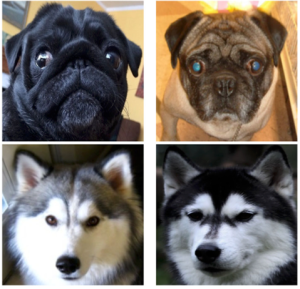
We acquired 374 photos licensed under Creative Commons from Flickr, representing 2 breeds (pugs and huskies), 21 individuals per breed, and at least 5 photos per individual. The choice of breeds intended to reflect a difficult case (pugs) and an easy one (huskies).
A pet that goes missing is among many people’s worst fears: a moment of distraction is enough for a dog or a cat wandering off from home. Some measures help matching lost animals to their owners; but automated visual recognition is one that is surprisingly overlooked.
In this article published at Multimedia Tools and Applications, the authors start a new path in face recognition for dogs. The paper evaluates if pet biometry can be useful for retrieving lost animals, complementing existing solutions.
The performance of off-the-shelf classical Human Facial Recognizers was rather poor for dogs, showing that dog facial recognition is not a trivial extension of human facial recognition. Convolutional Networks, both shallow and deep, proved more successful. The performance was very promising, especially when contrasted to the literature that shows that dog recognition is hard even for human dog experts.
The Flickr-dog dataset, adopted in the article, can be obtained here.
